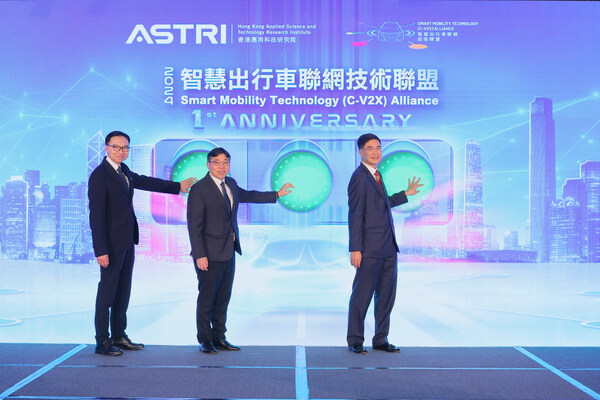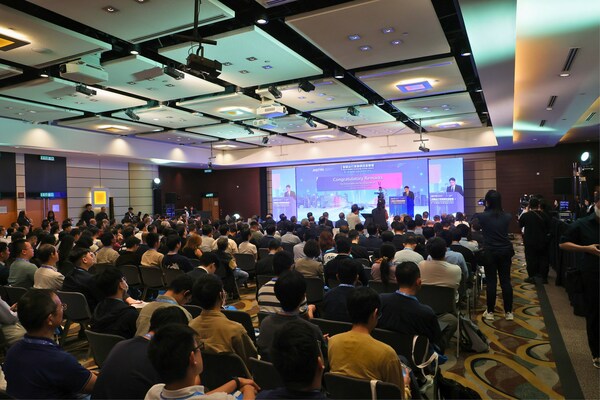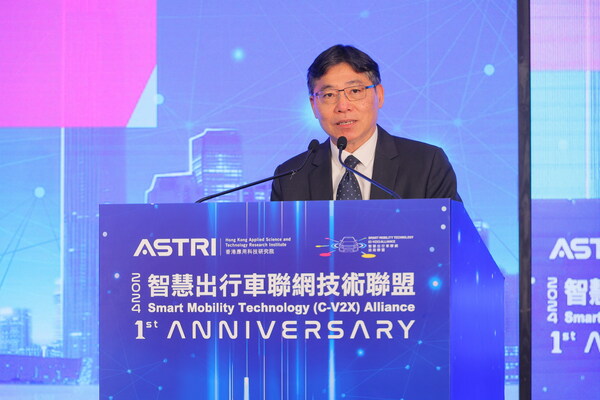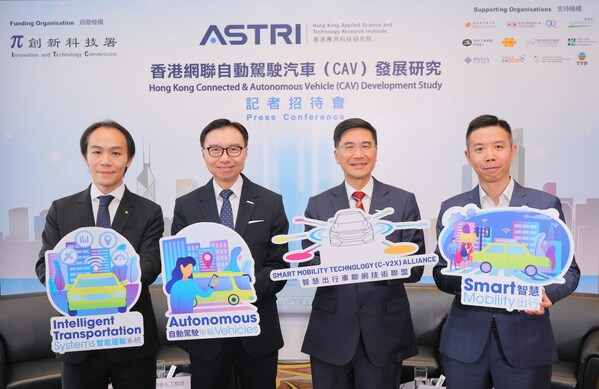Unveils Findings of First-of-its-kind Autonomous Vehicle Study in Hong Kong
HONG KONG, April 15, 2024 /PRNewswire/ — The Hong Kong Applied Science and Technology Research Institute (ASTRI) celebrated the first anniversary of the Smart Mobility Technology (C-V2X) Alliance (SMTA) and unveiled Hong Kong’s first in-depth study on the development of connected and autonomous vehicles (CAV). Mr Lam Sai-hung, Secretary for Transport and Logistics of the HKSAR Government attended the event, highlighting the city’s commitment to revolutionising smart mobility within the Greater Bay Area (GBA).
Autonomous ride in West Kowloon Cultural District
Mr Lam emphasised the government’s commitment to integrating innovation in transportation, “The Government has paved the way for wider and more flexible trials and application of autonomous vehicles in Hong Kong by introducing a new regulatory regime for trial and use of autonomous vehicles and the new framework came into effect just last month. This marks a key milestone of the Government’s continued efforts in promoting smart mobility and demonstrates our great ambition and strong commitment to further application and adoption of autonomous vehicles in Hong Kong,” he affirmed.
ASTRI integrated 5G with C-V2X[1] technology and conducted successful road tests. It is now preparing for a pilot of unmanned shuttle buses in the West Kowloon Cultural District, running from Xiqu Centre to Hong Kong Palace Museum.
ASTRI leads C-V2X technology development
Ir Sunny Lee, Chairman of ASTRI, stressed the organisation’s leading role in developing and promoting C-V2X technology for smart mobility. He said ASTRI fostered collaboration among stakeholders in the ecosystem and conducted tests integrating autonomous driving technology into the city’s transportation infrastructure. In addition, ASTRI expanded its cooperation with Shenzhen to develop cross-border C-V2X technology, extending the application scenarios and network infrastructure to Futian, Bao’an, Longhua, and Pingshan districts. ASTRI also partnered with the government of Xiangcheng District in Suzhou to jointly build the “Suzhou-Hong Kong Digital Transportation Innovation Corridor”.
Ir Lee envisioned that once cross-border vehicle networking matures, smart mobility will be realised in the Guangdong–Hong Kong–Macao Greater Bay Area (GBA), achieving seamless interconnectivity among people, vehicles, and roads, and enhancing the convenience of cross-bay area autonomous driving. “Hong Kong can replicate its successful experience and export C-V2X technology and smart mobility solutions to ASEAN countries, helping them address urbanisation challenges.”
SMTA promotes smart mobility
The SMTA has been instrumental in bringing together government, industry, academia and research institutions to revolutionise transportation through innovation and technologies, enhance users’ travel experiences and support Hong Kong’s smart city ambition.
Dr Denis Yip, Chief Executive Officer of ASTRI, highlighted SMTA’s achievements in perfecting the smart mobility ecosystem, with the support of 12 organisations and over 80 institutional members. He said SMTA has launched six research projects in partnership with various universities and collaborated with the industry to promote the application of vehicle connectivity technology.
“We also conducted in-depth research on C-V2X technology, including completing 900,000 kilometres of road testing across 10 trial sites, providing valuable data for further technology enhancement. The alliance also organised an array of activities, such as missions to Guangzhou, Shenzhen, Suzhou and Wuxi, helping industry players expand their business networks and explore new opportunities,” Dr Yip added.
Hong Kong’s first CAV study
Hong Kong’s first comprehensive study on the development of connected and autonomous vehicles (CAV) shows promising growth potential. ASTRI commissioned Deloitte China to conduct the study, which was funded by the Innovation and Technology Fund under the Innovation and Technology Commission[2].
The report examines the key success factors of industry-leading countries, including Korea, Netherlands, Singapore, the United Kingdom, and the United States, while shedding light on the unique advantages and opportunities in Mainland China, especially in the GBA. It also analyses the latest CAV development in Hong Kong, focusing on policy and regulation, infrastructure, R&D capabilities, supply of talent and access to funding.
Pull factors of CAV development
Several pull factors of the city’s CAV development are identified, including:
- The establishment and implementation of the Road Traffic Regulation which help facilitate the wider trials and use of AVs in a safe and orderly manner.
- The city’s robust telecommunications infrastructure, characterised by a stable and extensive 4G/5G network, acts as a significant driving force for the CAV development.
- The city’s free flow of information and effective IP protection support knowledge sharing and innovation development, while providing protection for automakers and technology developers.
- Hong Kong’s positioning as the GBA advanced manufacturing centre, coupled with support from the region’s research community, enhance prototyping and manufacturing of key vehicle components while facilitating testing and technology transfer in Hong Kong.
- Hong Kong boasts highly-ranked universities and enjoys geographical proximity to other cities in the GBA, providing a pool of skilled graduates in disciplines relevant to CAV technology and fostering a cross-border exchange of knowledge and expertise.
- The HKSAR Government’s comprehensive I&T funding schemes facilitate the adoption of technology by local enterprises and organisations, further supporting the CAV development in Hong Kong.
“Through vehicle-to-everything technology, CAV has the potential to revolutionise the transportation sector by enhancing road safety, improving transport and energy efficiency, and uplifting the travel experience of local commuters,” Ir Sunny Lee stated, “With concerted efforts, Hong Kong’s autonomous driving technology is set to become one of the most sought-after solutions in the world.”
Calling on industry players to prepare for the unmet market demand and enormous growth opportunities, Dr Denis Yip added, “By embracing new opportunities, through enhancing the foundation, coordinating the deepening the development, and creating an environment supportive of CAV technologies and its associated markets, Hong Kong is poised to create unstoppable momentum towards an autonomous future and unlock its tremendous potential as a leading smart city in the world.”
Tech talk by experts
During the ceremony, ASTRI signed a Memorandum of Understanding with The Centre for Innovation in Transport (CENIT) in Spain, enhancing mutual collaboration in research, information sharing and talent exchange to develop efficient and sustainable smart city solutions.
The anniversary event also featured talks from industry experts, including Dr Sergi Saurí, Director of CENIT; Mr Joseph Lam, General Manager of Technical Services Systems at the Airport Authority Hong Kong; Mr Newton Ng, Commercial Director of Citybus Limited; Mr Luca Verre, Co-founder and CEO of Prophesee; Mr Dongzhe Su, Director of Smart Mobility, ASTRI; and Mr Falcon Chan, Hong Kong Consulting Strategy and Transformation Offering Leader, Deloitte China, who shared their perspectives on the future of smart mobility.
To learn more about the Smart Mobility Technology Alliance, please visit: https://smta.astri.org/
Hong Kong Connected & Autonomous Vehicle (CAV) Development Study: https://bit.ly/3U0mja1
|
[1] Cellular Vehicle-to-Everything (C-V2X) technology refers to the low-latency communication system, connecting vehicles, pedestrians, infrastructure, and networks through real-time information transmission. It enhances road safety, assists driving, and improves traffic efficiency. |
About ASTRI
Hong Kong Applied Science and Technology Research Institute (ASTRI) was founded by the Government of the Hong Kong Special Administrative Region in 2000 with the mission of enhancing Hong Kong’s competitiveness through applied research. ASTRI’s core R&D competence in various areas is grouped under five Technology Divisions: Advanced Electronic Components and Systems; Artificial Intelligence and Trust Technologies; Communications Technologies; Innovative Mind, and IoT Sensing and AI Technologies. It is applied across six core areas which are Smart City, Financial Technologies, New-Industrialisation and Intelligent Manufacturing, Digital Health, Application Specific Integrated Circuits and Metaverse.
Over the years, ASTRI has nurtured a pool of research, I&T talents and received numerous international awards for its pioneering innovations as well as outstanding business and community contributions. ASTRI has transferred more than 1,400 technologies to the industry and has been granted over 1,050 patents in the Mainland, the United States, and other countries. For further information, please visit www.astri.org.
Photos Download: https://bit.ly/3vGpZFN
(From left to right) Ir Sunny Lee, Chairman of ASTRI, Mr Lam Sai Hung, Secretary for Transport and Logistics, HKSAR Government, and Dr Denis Yip, Chief Executive Officer of ASTRI celebrate the first anniversary of the Smart Mobility Technology (C-V2X) Alliance today (15 April)
Some 300 technology experts and leaders from the smart mobility ecosystem gather at HKCEC to celebrate the first anniversary of ASTRI’s Smart Mobility Technology (C-V2X) Alliance
Mr Lam Sai Hung, Secretary for Transport and Logistics of the HKSAR Government, speaks at the ceremony
Dr Denis Yip, Chief Executive Officer of ASTRI, introduces Hong Kong’s advances in smart mobility and CAV development
ASTRI unveils Hong Kong’s first in-depth study on the development of connected and autonomous vehicles (CAV). (From left to right) Mr Robert Lui, Capital Market Services Group Hong Kong Leader, Deloitte China; Ir Sunny Lee, Chairman of ASTRI; Dr Denis Yip, CEO of ASTRI; Mr Falcon Chan, Hong Kong Consulting Strategy and Transformation Offering Leader, Deloitte China
View original content to download multimedia: Read More





